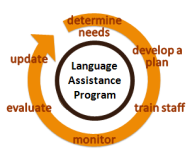Click here to share this page with your professional network
Limited English Proficiency Planning
Why you may need help
Having the right Language Assistance Program can help you meet your customer service needs and limited English proficiency obligations if you manage a federally-assisted program or activity. This is key to delivering services well and ensuring against disparate treatment of non-English speakers. You will manage risk by avoiding civil rights complaints and penalties.
Organizations often don’t have time to gather figures and facts and conduct the required in-depth analyses to do a Language Needs Assessment and develop the Language Access Plan. That's why they call on the experience and know-how of Gary E. Hanes & Associates, LLC.
More on Language Assistance Programs
America is becoming more diverse. There is an increasing number of people that do not speak, read or write English very well--they are limited English proficient (LEP). This presents challenges that managers of federally-assisted housing and other programs must meet and it creates opportunities to increase access to these programs.
Title VI of the Civil Rights Act requires that federally-assisted programs and services be delivered free of discrimination based on national origin along with the other protected classes. This means that important information must be provided without cost in a competent and timely way and in the language of the LEP person.
All programs that receive federal assistance must address limited English proficiency. This includes:
- State and local agencies
- Private and nonprofit entities
- Subrecipients
- Specifically: Assisted housing providers
Each federal agency provides guidance on how to develop a Language Assistance Program. A Language Assistance Program includes a written Language Needs Assessment and a Language Access Plan.
The Language Needs Assessment has four parts:
- The number or proportion of LEP persons eligible to be served or likely to be encountered by the program or grantee;
- The frequency with which LEP persons come in contact with the program;
- The nature and importance of the program, activity, or service provided by the program to people’s lives; and
- The resources available to the grantee/recipient and costs.
The Language Access Plan will cover policies and procedures that address:
- Identifying LEP Individuals Who Need Language Assistance
- Language Assistance Measures (interpretation and translation)
- Staff Training
- Notice to LEP Persons
- Monitoring and Updating the Language Access Plan
There are cross-cutting considerations that may also affect your federally-assisted program and influence steps you must take for dealing with limited English proficiency. These include:
- Affirmative marketing
- Davis-Bacon prevailing wage monitoring activities
- Americans with Disability Act (ADA) and Section 504 of the Rehabilitation Act
- Environmental Justice
Links to more helpful information



